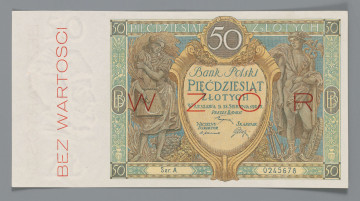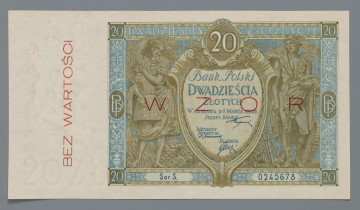
Cheque for 50,000,000 Polish marks - a template
1923
National Museum in Lublin
Part of the collection: Paper money during the Second Polish Republic
One of the most important Polish economic achievements of the 1920s was the reform of Władysław Grabski. It took place in a very difficult situation. On top of the devastation caused by the recently-ended war with Soviet Russia, there was the fragmentation of the Polish political scene in the early 1920s. This made it difficult to form a stable majority, and hence a government with a strong parliamentary base. In this situation, it was clear to Władysław Grabski, appointed Prime Minister on 17 December 1923, that he did not have much time to carry out the reforms that the economy required. The plan to improve the state's finances that he had devised was therefore put into effect very quickly. One of its most important elements was a currency reform involving the introduction of a new currency in the form of the zloty, combined with denomination. The start of the reform was set for 28 April 1924. It was clear that the government, which had been appointed just four months earlier, would not succeed in providing enough new money. The situation was to a large extent saved by the fact that, in the warehouses of Bank Polski, established on 14 April 1924, there were crates of zloty banknotes printed in 1919, which could not enter circulation at that time. They were therefore used now. Market needs and the still unstable financial situation forced the government to print more banknotes. The issue of five-, ten- and twenty-zloty banknotes, which was dated 15 July 1924, did not in principle differ from the 1919 issue. It was due to the fact that the same printing plates were used as had been made five years earlier in the French workshop of Professor Egène Gaspé. It is not known who made the necessary changes, including the legal clause, which was erroneously edited in 1919. These banknotes were gradually put into circulation in the second half of 1924 and early 1925. In the case of the five-zloty banknote, it happened on 30 September 1924. Its market life was not very long, as the withdrawal date was set to 30 September 1925 and the final exchange date to 31 March 1926.
The banknote specimen is in excellent condition. Like the other designs it is clearly marked with two diagonal red lines and the inscriptions ‘MODEL’ and ‘No value’.
Leszek Poniewozik
Author / creator
Dimensions
cały obiekt: height: 127 mm, width: 89 mm
Object type
paper money
Technique
Material
paper
Creation time / dating
Creation / finding place
Owner
The National Museum in Lublin
Identification number
Location / status

1923
National Museum in Lublin

1925
National Museum in Lublin

1926
National Museum in Lublin
DISCOVER this TOPIC
National Museum in Lublin
DISCOVER this PATH
Educational path